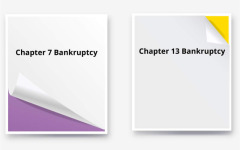The Differences Between Chapter 7 and Chapter 13 Bankruptcy
When you decide to file for bankruptcy, you’re going to be facing a few decisions to make. One such decision is exactly what type of bankruptcy you want to file for. There are two common types—chapter 7 and 13—as well as others (such as chapter 11) that are outside the scope of this blog. Most likely you will be deciding between a 7 and 13. To help you make your choice, here are a few key differences between the two.
Chapter 7 Bankruptcy: Not for Everyone
To start with, you should understand that you may not be eligible for a chapter 7 if you make too much money. There is a means test utilized by chapter 7; this test looks at your disposable income. If it is above a certain amount—and this amount will vary depending on a number of factors, including where you live—then you are not able to file a chapter 7 bankruptcy. If you are not sure whether you qualify for a chapter 7 bankruptcy, the best thing to do is talk to a bankruptcy attorney. You can contact us for a Free Bankruptcy Consultation. They will be able to clear things up for you as well as offer some insight into which type of bankruptcy may be best for you in your present situation.
Other Differences Between Chapter 7 Bankruptcy and Chapter 13 Bankruptcy
Of course, the differences don’t stop with the threshold income requirements. Here are a few key differences between these two types of bankruptcy filings.
- Eligibility to file. While an individual may file either a chapter 7 or 13, a business entity cannot file a chapter 13.
- Timing. A chapter 7 bankruptcy is much faster than a 13. A chapter 7 bankruptcy can take 3-5 months, while a chapter 13 bankruptcy can take 3-5 years.
- Effect on property. A chapter 7 bankruptcy involves liquidating all but your exempt property. In a 13 you can keep non-exempt property if you wish.
- Effect on liens. In a chapter 7, junior liens on real property will survive; in a chapter 13 these liens may be stripped from the property after certain requirements are met.
- Different disadvantages. With a chapter 7, there is no way for the debtor to catch up on payments he or she missed to avoid foreclosure or repossession. In a chapter 13, the debtor may have to pay part of the unsecured debts that would have been discharged in a chapter 7 bankruptcy.
The information in this post is for educational purposes only. It should not be interpreted as legal advice.
Find Similar Articles
Contact Us
For more information please fill out the form below.
(*) - Required field

